Common Causes of Car Accidents
Virginia Beach Car Accident Lawyers
Most car accidents result from human error. In fact, the National Highway Traffic Safety Administration (NHTSA) found that between 94 to 96 percent of all motor vehicle accidents are caused by human error. For this reason, motorists should be aware of the most common causes of car accidents and how collisions can be avoided. Some common reasons for car accidents are listed below.
Speeding

Drivers breaking the speed limit is a major problem in the United States. Sometimes, speeding is not necessarily breaking the posted speed limit, but driving too fast for the current road conditions. In Virginia, climate changes can play a big part in determining how fast a car can safely travel. For example, maintaining a speed of 50 miles per hour can be dangerous in a rainstorm, even if the driver is not going above the speed limit.
Most drivers are tempted to go above the speed limit, and this is particularly true when it is perceived to be far too low for the road. There is a natural inclination in humans to get to the destination the fastest way that is possible. Speed limits are not set arbitrarily, they are designed to accommodate traffic patterns in the area, road conditions, pedestrian and bicycle traffic, residential and commercial buildings in the area, and traffic lights and stop signs.
Tailgating
Tailgating occurs when a driver is following the car in front of them too closely. In Virginia, a driver should not follow too closely to another vehicle. When a driver tailgates, they do not have enough time to stop safely in an emergency situation. Tailgating is a root cause of rear-end accidents.
Tailgating in fast moving traffic is more likely to cause an accident because drivers have less time to react to an emergency. For example, a car going 50 miles per hour needs 229 feet, or the length of 15 cars, to stop. The distance needed to stop is less if the car is moving at a slower pace. However, this does not mean that accidents do not happen in slow moving traffic. Many collisions happen in both morning and evening commutes.
A good rule of thumb many people learn in driving school is to keep a three-second distance from the car in front. This works when cars are travelling at the same speed, but the Virginia Department of Motor Vehicles (DMV) recommends a four- to five-second buffer from the car in front at all times.
Factors to consider when determining if one is following too closely:
- Speed of both vehicles.
- Amount of traffic on the road.
- Types of vehicles. Heavier vehicles will take longer to stop.
- Weather and hazardous road conditions. The driver in front may need to slam on the brakes in response to traffic, or they may need to stop frequently during a weather event, such as ice.
- Time of day. In daylight, changing road conditions are much clearer than at night.
- Perception time. How long it takes the driver to realize a change in the road.
- Following distance. A motorist should give enough following distance between them and the driver in front. It is the job of the driver to watch what is happening around them.
Distracted Driving
Distracted driving has become more prominent with the emergence of cellphones and smart technology. Virginia drivers should learn about the main causes of distracted driving accidents to prevent injuries and even fatalities.
Some common causes of distracted driving accidents include:
- Rubbernecking
- Talking to passengers
- Adjusting the radio
- Cellphone use
- Eating and drinking
- Personal grooming
- Reaching for objects
- Adjusting the navigation system

There are many different types of distractions, but cellphone use is a top cause of accidents. Using a cellphone while driving is illegal in Virginia. On Jan. 1, 2021, a new hands-free law became effective. The state prohibited holding a cellphone or any other wireless device while driving. An exception is when the driver is legally parked or stopped. Specifically, texting while driving is illegal, and it is a primary offense in Virginia. With the efforts of both auto and cellphone manufacturers to reduce drivers becoming distracted by their phones, Bluetooth technology allows motorists to text, call, email, and ask for directions by voice command.
Drowsy Driving
Driving while fatigued is comparative to driving under the influence of an intoxicating substance; the driver is not going to react quickly or well to changes in the road ahead. It is known that many drowsy drivers catch micro-naps for a few seconds at a time, which is enough time to get into an accident.
Drunk Driving
People driving under the influence of an intoxicating substance are far less likely to react appropriately to changing conditions in the road. With concerted efforts by student and parent groups and alcoholic beverage manufacturers and government agencies, more people are choosing to not get behind the wheel after a few drinks. This is avoidable by getting a ride from a sober friend or calling a rideshare service or taxi.
Drugged Driving
Using recreational marijuana became legal in Virginia on July 1, 2021, however, it is not legal to drive after smoking marijuana. Additionally, motorists should not drive under the influence of prescription drugs. While a doctor’s prescription gives a person a reason to take the medication, it does not mean they can legally drive while under the influence. Some medications cause drowsiness and other adverse side effects.
Running Red Lights
There is always a temptation for drivers to get through an intersection before the light turns red. However, the driver on the other side of the intersection is not going to know that a driver will go through the red light and is likely to move forward as soon as the light turns green. Even if both drivers have their focus on the road and two hands on the wheel, an accident is likely to happen.
Defective Automobiles, Tires, or Airbags
Not all problems on the road are the result of poor decisions made by a driver. General Motors (GM) recalled millions of vehicles in 2020 due to defective airbags. Chevy Bolts have been recalled for a battery that catches fire. Defective tires can blow out and cause a driver to lose control of a vehicle.
Wrong-Way Driving
Turning onto a one-way street in the wrong direction can cause an accident, and it can easily happen to a driver who is in an unfamiliar area or a busy urban neighborhood. Wrong-way accidents also happen on highway entry and exit ramps.
What are Common Car Accident Injuries?
There are many different causes of car accidents, and significant injuries can happen any time one happens. Some common car accident injuries include:

- Broken bones: Broken ribs and broken collar bones are common in all types of accidents. A broken collarbone is extremely painful, and it makes it hard for person to lift their arm. Broken ribs make breathing difficult and sometimes, it can puncture the lungs.
- Internal organ damage: Internal organs may be forced into the chest wall by momentum. This can lead to damage to the organs and internal bleeding. Often, people who suffer from internal bleeding do not know they have an injury. This is yet another reason to get to a doctor immediately following a collision.
- Ruptured bowels: A rupture in the bowel can mean waste and bile, the acid that breaks down food, are leaking into the body. That waste is poisonous and can be deadly. Bowels can be moved around from the collision, just like the internal organs, and that movement can mean damage.
- Head injuries: Concussions are likely following a car accident, as the head is moving around too, possibly slamming into an object in the car or being hit by something. The most concerning head injury is also very possible: a traumatic brain injury (TBI).
- Spinal cord injuries: A spinal cord injury can cause a total loss of sensation and mobility, it means paralysis or partial paralysis.
- Nerve damage: A lack of sensation or tingling pain in a body part is an indicator of nerve damage.
- Soft tissue injuries: When muscles, tendons, or ligaments become damaged, it is extremely painful, and treatment may involve surgery as well as physical therapy.
While people involved in a serious car accident may feel like they are okay because there is no obvious pain or bleeding, seeing a doctor right away is still the best course of action. Internal bleeding is not going to be obvious, and many people have delayed symptoms following a crash. This is the result of adrenaline and endorphins, and even obvious injuries might not be painful right away.
What is Pure Contributory Negligence?
The Commonwealth of Virginia operates under the legal concept of “pure” contributory negligence regarding car accidents. Most of the United States operate under the legal doctrine of comparative negligence, which splits the damages according to the degree of fault of each driver involved. For example, under comparative negligence, a driver found to be 20 percent at fault would receive 80 percent of the compensation sought. With pure contributory negligence, a driver found to be even one percent at fault can lose the right to sue in court. Insurance companies operate under this principle as well as courtrooms, so the funds available to drivers involved may be much smaller than the claims demand, even if all parties are insured. To protect a claim from being denied by an insurance carrier based on pure contributory negligence, the driver needs to be 100 percent not at fault for the accident. Virginia allows drivers to file lawsuits against negligent parties for compensation to cover medical costs, lost wages, reduced earning capacity, and pain and suffering.
What Steps Should I Take Immediately Following a Car Accident?
When an accident occurs, those involved are likely overwhelmed and traumatized. However, it is important to remain calm after a collision. Some other steps to take include:
- Check to see everyone is okay. Attend to those who are injured.
- Call 911 to get emergency services and police to the scene. The emergency services paramedics will be able to provide medical care.
- Get a police report. A police report will help guide the insurance company on what happened, and it will be used if the case goes to court as well.
- Exchange insurance information with the other people involved.
- Document injuries and losses at the scene. Using the cellphone camera can be helpful.
- Call the insurance company to get the claims process started.
- Contact a car accident lawyer.



